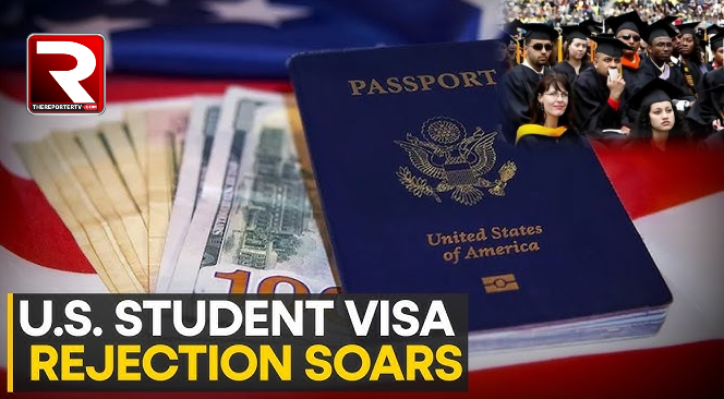The United States has witnessed a dramatic surge in F-1 student visa rejections, reaching a decade-high rejection rate of 41% during the fiscal year 2023-24. This sharp increase has placed significant strain on international students, particularly those from India, who have historically made up a large portion of the student visa applicants. The rise in rejections signals a broader shift in U.S. immigration policy, raising concerns for the future of international education.
What is an F-1 Visa?
The F-1 visa is a non-immigrant visa that allows international students to enter the U.S. for the primary purpose of pursuing full-time academic studies at accredited institutions. To qualify, students must be accepted by a school certified by the Student and Exchange Visitor Program (SEVP) and must maintain a full course load during their studies.
Key Features of the F-1 Visa:
Purpose: Designed for academic study, not for work or permanent residency.
Eligibility: Applicants must be accepted by an accredited U.S. institution and maintain full-time enrollment.
Duration: The visa’s validity is based on the length of the academic program, with potential extensions for Optional Practical Training (OPT).
Work Opportunities: F-1 students can work on-campus under certain conditions and may apply for internships related to their field of study after completing their program.
Dependents: Spouses and children of F-1 visa holders can join the student on F-2 visas, though they are not allowed to work.
A Closer Look at F-1 Visa Denials
In the fiscal year 2023-24, the U.S. received approximately 679,000 F-1 visa applications, but only 401,000 visas were issued, leaving 279,000 denied. This marks a significant decrease in approvals compared to the previous year, with a 38% drop in the number of F-1 visas granted to Indian students between January and September 2024. This decline comes even as India has become the largest source of international students in the U.S., surpassing China for the first time since 2009.
Statistics Overview:
Total F-1 Applications: 679,000
Denials: 279,000
Issued Visas: 401,000 (down from 445,000 in the previous year)
F-1 Visas Issued to Indian Students (2024): 63,973 (down 38% from 103,000 in 2023)
Impact on Indian Students
Indian students have borne the brunt of the increased rejections. With the steep decline in visa issuances, many Indian students now face greater uncertainty about their future educational prospects in the U.S. This trend is leading some to reconsider alternative destinations like Canada or the UK, where immigration policies may be more favorable.
Broader Implications:
Limited Options: Other countries, such as Canada, have also begun to tighten their student visa policies, further limiting options for international students.
Changing Trends in Global Mobility: As U.S. visa policies tighten, students may increasingly seek educational opportunities in countries with more favorable immigration rules, impacting U.S. universities’ global appeal.
Reasons Behind Increased Rejections
The U.S. State Department attributes the increase in visa denials to stricter compliance with the Immigration and Nationality Act and updates to data methodologies since 2019. Common reasons for rejection include:
Insufficient Evidence of Non-Immigrant Intent: Applicants must prove they intend to return to their home country after their studies.
Incomplete Applications: Missing or inaccurate documentation can result in denials.
Previous Visa Denials: A history of prior rejections can negatively impact future applications.
Navigating the Visa Process
In light of the increased rejections, prospective students can take several proactive steps to improve their chances of securing an F-1 visa. These steps include early preparation, organizing required documentation, and demonstrating strong ties to their home country.
Key Tips for Improving F-1 Visa Approval Chances:
Start Early: Begin the application process well in advance to ensure all documents are in order.
Organize Documents: Ensure all required documents—passport, Form I-20, financial proof, and academic records—are ready and properly organized.
Demonstrate Strong Ties to Home Country: Show evidence of your intent to return home after completing your studies, such as family connections or job prospects.
Prepare Financially: Prove your ability to cover tuition and living expenses by providing sufficient financial documentation.
Prepare for the Interview: Practice answering common interview questions and research your program and university to demonstrate commitment and clarity in your goals.
Seek Guidance: Consulting an immigration lawyer or international student office can help navigate the complex process.
Recent Global Developments
The tightening of U.S. student visa policies reflects a broader international trend of countries reassessing their approach to foreign student admissions. For instance, Canada has introduced restrictions on study permits in response to growing pressures on housing and public services. As these changes unfold, Indian students may increasingly look beyond the U.S. for their educational opportunities.
Conclusion
The rising rejection rate of F-1 visas poses a significant challenge for international students, especially those from India. As the global landscape of student mobility continues to evolve, prospective students must be prepared to navigate a more competitive and restrictive environment. While the U.S. remains a top destination for higher education, the tightening of its immigration policies may encourage students to explore other educational opportunities abroad. The coming years will likely see more international students seeking alternatives as the immigration policies of major host countries continue to shift in response to domestic pressures.












